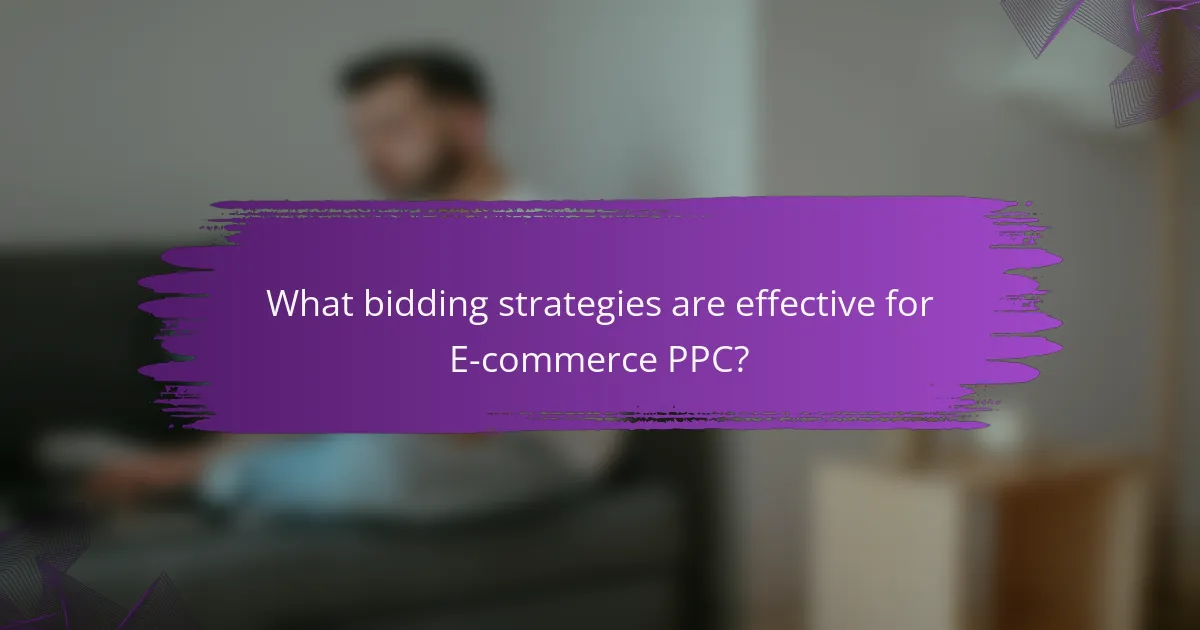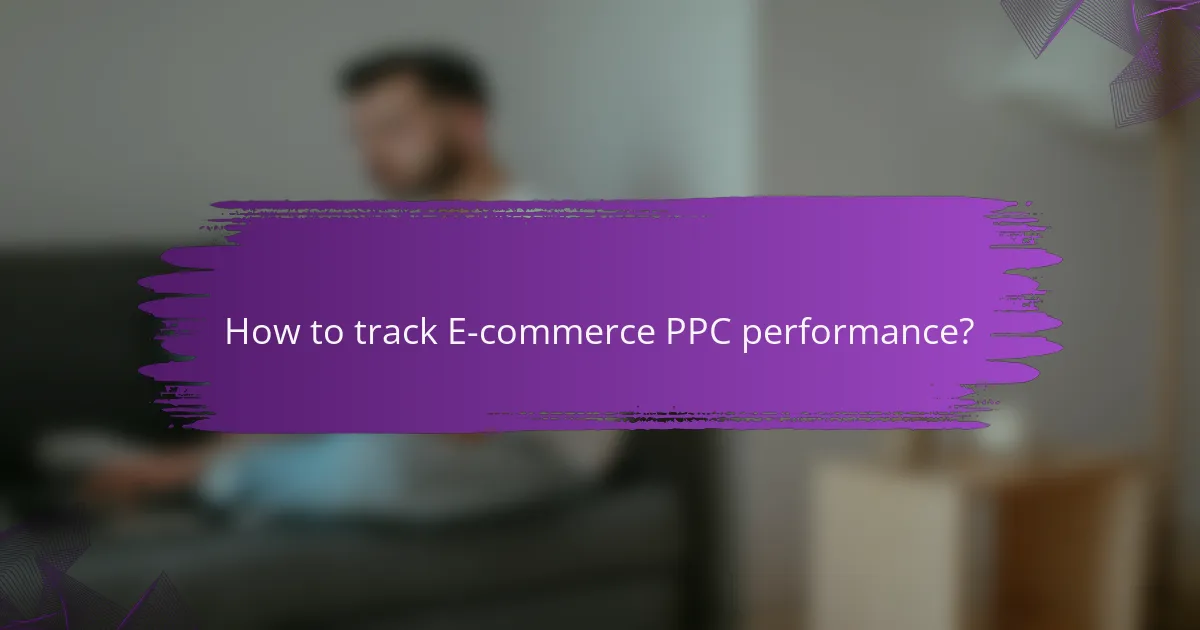E-commerce PPC campaigns require careful budgeting, strategic bidding, and diligent tracking to ensure optimal performance and return on investment. By setting financial limits that align with revenue goals and employing effective bidding strategies, businesses can enhance their ad spend efficiency. Additionally, monitoring key performance metrics allows for continuous optimization and improvement of campaigns.

How to budget for E-commerce PPC campaigns?
Budgeting for E-commerce PPC campaigns involves setting financial limits that align with your revenue objectives while ensuring effective ad spend. A well-planned budget helps maximize return on investment (ROI) and optimizes campaign performance over time.
Allocate budget based on revenue goals
Start by determining your revenue targets to allocate your PPC budget effectively. For instance, if your goal is to achieve $10,000 in sales, consider how much you’re willing to spend to reach that target, often aiming for a return of at least 3 to 5 times your ad spend.
Break down your budget into specific campaigns or product categories, ensuring that higher-margin products receive a larger share of the budget. This targeted approach can help optimize your overall profitability.
Use historical data for forecasting
Leverage historical performance data to inform your PPC budgeting decisions. Analyze past campaigns to identify trends in cost-per-click (CPC), conversion rates, and overall sales performance.
Utilizing tools like Google Ads or analytics platforms can provide insights into which keywords and ads have historically performed well, allowing you to allocate funds more effectively for future campaigns.
Consider seasonality and market trends
Seasonality can significantly impact E-commerce sales, so adjust your budget according to peak shopping periods. For example, allocate more funds during holidays or major sales events when consumer spending typically increases.
Stay informed about market trends and competitor activity, as these factors can influence your PPC strategy. Adjust your budget to remain competitive and capture market share during critical times.
Set daily and monthly spending limits
Establish daily and monthly spending limits to maintain control over your PPC budget. Daily limits help prevent overspending and ensure consistent ad visibility throughout the month.
Consider using automated bidding strategies that align with your budget constraints, allowing for flexibility while adhering to your financial goals. Regularly review and adjust these limits based on campaign performance and changing business objectives.

What bidding strategies are effective for E-commerce PPC?
Effective bidding strategies for E-commerce PPC include manual bidding, automated bidding, target cost-per-acquisition (CPA), and maximizing conversions. Each strategy has its own advantages and is suited for different business goals and budget constraints.
Manual bidding for control
Manual bidding allows advertisers to set specific bids for each keyword or ad group, providing granular control over spending. This strategy is ideal for those who want to optimize their campaigns based on performance data and specific business objectives.
To implement manual bidding effectively, regularly review performance metrics and adjust bids accordingly. Consider starting with a moderate bid and gradually increasing it for high-performing keywords to maximize ROI.
Automated bidding for efficiency
Automated bidding uses algorithms to adjust bids in real-time based on various factors, such as competition and user behavior. This strategy is beneficial for advertisers who prefer a hands-off approach and want to save time on bid management.
While automated bidding can improve efficiency, it is crucial to monitor performance closely. Set clear goals and use automated strategies that align with your objectives, such as maximizing clicks or conversions.
Target CPA for cost management
Target CPA bidding focuses on achieving a specific cost per acquisition, making it easier to manage advertising budgets effectively. This strategy is particularly useful for E-commerce businesses aiming to maintain profitability while driving conversions.
To use target CPA effectively, analyze historical conversion data to set realistic CPA goals. Adjust your target as needed based on performance trends and market conditions to ensure you remain competitive.
Maximize conversions for growth
Maximizing conversions bidding aims to generate the highest number of conversions within a specified budget. This strategy is ideal for businesses focused on growth and expanding their customer base.
When using this approach, ensure that your tracking is set up correctly to capture all relevant conversion actions. Regularly review conversion rates and adjust your budget allocation to prioritize high-performing campaigns for optimal results.

How to track E-commerce PPC performance?
Tracking E-commerce PPC performance involves monitoring various metrics to assess the effectiveness of your campaigns. This process helps identify areas for improvement and optimize your advertising budget.
Use Google Analytics for insights
Google Analytics is a powerful tool for tracking E-commerce PPC performance. By linking your PPC campaigns to Google Analytics, you can gain insights into user behavior, traffic sources, and conversion rates.
To set this up, ensure that your Google Ads account is connected to Google Analytics. This integration allows you to view detailed reports, such as which keywords are driving the most traffic and how users interact with your site after clicking on your ads.
Implement conversion tracking
Conversion tracking is essential for understanding the effectiveness of your PPC campaigns. It allows you to measure specific actions taken by users, such as purchases or sign-ups, after clicking on your ads.
To implement conversion tracking, set up conversion goals in your advertising platform, whether it’s Google Ads or another service. This setup will enable you to attribute conversions directly to your PPC efforts, helping you evaluate ROI accurately.
Monitor key performance indicators
Key performance indicators (KPIs) are critical for assessing the success of your E-commerce PPC campaigns. Common KPIs include click-through rate (CTR), cost per click (CPC), conversion rate, and return on ad spend (ROAS).
Regularly review these metrics to identify trends and make data-driven decisions. For example, a declining CTR may indicate that your ad copy needs improvement, while a low conversion rate could suggest issues with your landing page.
Utilize UTM parameters for campaigns
UTM parameters are tags added to your URLs that help track the performance of specific campaigns in Google Analytics. By using UTM parameters, you can gain insights into which ads are driving traffic and conversions.
To create UTM parameters, use Google’s Campaign URL Builder. Include details like the campaign source, medium, and name. This practice allows for granular tracking and helps refine your PPC strategies based on performance data.

What are the best practices for optimizing E-commerce PPC?
To optimize E-commerce PPC effectively, focus on continuous performance evaluation, strategic testing, and data-driven adjustments. Implementing these practices can significantly enhance ad efficiency and return on investment.
Regularly review ad performance
Consistent review of ad performance is crucial for identifying trends and areas for improvement. Analyze metrics such as click-through rates, conversion rates, and cost per acquisition to gauge effectiveness.
Set a schedule for performance reviews, such as weekly or bi-weekly, to ensure timely adjustments. Use tools like Google Ads or analytics platforms to streamline this process and gather actionable insights.
Test ad copy and landing pages
Testing different ad copies and landing pages helps determine what resonates best with your audience. A/B testing can be particularly effective; try variations in headlines, calls to action, and visuals to see which combinations yield higher engagement.
Ensure that landing pages are relevant to the ad content and optimized for mobile devices. Small changes, like altering button colors or simplifying forms, can lead to significant improvements in conversion rates.
Adjust bids based on performance data
Adjusting bids based on performance data allows you to allocate budget more effectively. Increase bids for high-performing keywords and reduce or pause spending on underperforming ones to maximize return on ad spend.
Consider using automated bidding strategies offered by platforms like Google Ads, which can optimize bids in real-time based on performance metrics, ensuring you’re competitive in the auction without overspending.
Utilize negative keywords to refine targeting
Incorporating negative keywords into your PPC strategy helps prevent ads from showing for irrelevant searches. This refinement enhances targeting, ensuring that your budget is spent on clicks that are more likely to convert.
Regularly update your list of negative keywords based on search term reports. Focus on terms that attract clicks but do not lead to conversions, as they can drain your budget without delivering results.

What criteria should be considered for E-commerce PPC success?
To achieve success in E-commerce PPC, focus on key criteria such as budget management, effective bidding strategies, accurate tracking, and ongoing optimization. Each aspect plays a crucial role in maximizing return on investment and ensuring that campaigns reach their full potential.
Budgeting
Effective budgeting is vital for E-commerce PPC campaigns. Start by determining your overall marketing budget and allocate a specific portion to PPC based on your sales goals and profit margins. A common approach is to set aside around 5-10% of your projected revenue for online advertising.
Consider using a daily budget that aligns with your sales cycle, adjusting it during peak seasons or promotional events. Regularly review your spending to ensure it aligns with performance metrics and adjust as necessary to avoid overspending.
Bidding
Bidding strategies can significantly impact your ad visibility and cost-effectiveness. Choose between manual bidding, where you set specific bids for keywords, or automated bidding, which adjusts bids based on performance data. For many E-commerce businesses, a combination of both can yield optimal results.
Monitor your cost-per-click (CPC) and return on ad spend (ROAS) to refine your bidding strategy. Aim for a CPC that allows for a healthy profit margin while maintaining competitive positioning in search results.
Tracking
Accurate tracking is essential for measuring the success of your E-commerce PPC efforts. Implement tracking tools like Google Analytics and conversion tracking pixels to monitor user interactions and conversions effectively. This data will help you understand which campaigns and keywords are driving sales.
Regularly analyze your tracking data to identify trends and areas for improvement. Look for metrics such as click-through rates (CTR), conversion rates, and average order value to gauge performance and make informed decisions.
Optimization
Ongoing optimization is crucial for maintaining and improving PPC campaign performance. Regularly review your ad copy, keywords, and landing pages to ensure they are relevant and engaging. A/B testing different elements can help identify what resonates best with your audience.
Consider using negative keywords to filter out irrelevant traffic and improve your ad targeting. Additionally, adjust your bids based on performance data to allocate more budget to high-performing campaigns while reducing spend on underperforming ones.